182 books about Space Science and 13
start with M
182 books about Space Science and 13
182 books about Space Science
13 start with M start with M
13 start with M start with M
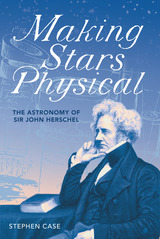
Making Stars Physical
The Astronomy of Sir John Herschel
Stephen Case
University of Pittsburgh Press, 2018
Making Stars Physical offers the first extensive look at the astronomical career of John Herschel, son of William Herschel and one of the leading scientific figures in Britain throughout much of the nineteenth century. Herschel’s astronomical career is usually relegated to a continuation of his father, William’s, sweeps for nebulae. However, as Stephen Case argues, John Herschel was pivotal in establishing the sidereal revolution his father had begun: a shift of attention from the planetary system to the study of nebulous regions in the heavens and speculations on the nature of the Milky Way and the sun’s position within it.
Through John Herschel’s astronomical career—in particular his work on constellation reform, double stars, and variable stars—the study of stellar objects became part of mainstream astronomy. He leveraged his mathematical expertise and his position within the scientific community to make sidereal astronomy accessible even to casual observers, allowing amateurs to make useful observations that could contribute to theories on the nature of stars. With this book, Case shows how Herschel’s work made the stars physical and laid the foundations for modern astrophysics.
Through John Herschel’s astronomical career—in particular his work on constellation reform, double stars, and variable stars—the study of stellar objects became part of mainstream astronomy. He leveraged his mathematical expertise and his position within the scientific community to make sidereal astronomy accessible even to casual observers, allowing amateurs to make useful observations that could contribute to theories on the nature of stars. With this book, Case shows how Herschel’s work made the stars physical and laid the foundations for modern astrophysics.
[more]
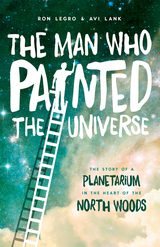
The Man Who Painted the Universe
The Story of a Planetarium in the Heart of the North Woods
Ron Legro
Wisconsin Historical Society Press, 2015
As a young boy Frank Kovac Jr. fell deeply in love with stargazing, painting glow-in-the-dark constellations on his bedroom wall and inviting friends to an observatory he built in his Chicago backyard. As he reached adulthood, Kovac did not let go of his childhood dreams of reaching the stars. He began scheming to bring the universe home. While working at a paper mill as a young man, Kovac tirelessly built a 22-foot rotating globe planetarium in the woods. Despite failures and collapses, the amateur astronomer singlehandedly built a North Woods treasure, painting more than 5,000 glowing stars—dot by dot in glowing paints. Today, Kovac and his unique planetarium take visitors to the stars every day.
The Man Who Painted the Universe: The Story of a Planetarium in the Heart of the North Woods introduces readers to the mild-mannered astronomy enthusiast whose creativity, ingenuity, fervor, and endurance realized a dream of galactic proportions. The story of this stargazer from Wisconsin’s North Woods so inspired two newspapermen, authors Ron Legro and Avi Lank, that they sought to document the story of the Kovac Planetarium for a new generation of stargazers and dreamers.
The Man Who Painted the Universe: The Story of a Planetarium in the Heart of the North Woods introduces readers to the mild-mannered astronomy enthusiast whose creativity, ingenuity, fervor, and endurance realized a dream of galactic proportions. The story of this stargazer from Wisconsin’s North Woods so inspired two newspapermen, authors Ron Legro and Avi Lank, that they sought to document the story of the Kovac Planetarium for a new generation of stargazers and dreamers.
[more]
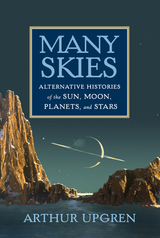
Many Skies
Alternative Histories of the Sun, Moon, Planets, and Stars
Upgren, Arthur
Rutgers University Press, 2012
What if Earth had several moons or massive rings like Saturn? What if the Sun were but one star in a double-star or triple-star system? What if Earth were the only planet circling the Sun?
These and other imaginative scenarios are the subject of Arthur Upgren's inventive book Many Skies: Alternative Histories of the Sun, Moon, Planets, and Stars. Although the night sky as we know it seems eternal and inevitable, Upgren reminds us that, just as easily, it could have been very different.
Had the solar sytem happened to be in the midst of a star cluster, we might have many more bright stars in the sky. Yet had it been located beyond the edge of the Milky Way galaxy, we might have no stars at all. If Venus or Mars had a moon as large as ours, we would be able to view it easily with the unaided eye. Given these or other alternative skies, what might Ptolemy or Copernicus have concluded about the center of the solar sytem and the Sun?
This book not only examines the changes in science that these alternative solar, stellar, and galactic arrangements would have brought, it also explores the different theologies, astrologies, and methods of tracking time that would have developed to reflect them. Our perception of our surroundings, the number of gods we worship, the symbols we use in art and literature, even the way we form nations and empires are all closely tied to our particular (and accidental) placement in the universe.
Many Skies, however, is not merely a fanciful play on what might have been. Upgren also explores the actual ways that human interferences such as light pollution are changing the night sky. Our atmosphere, he warns, will appear very different if we have belt of debris circling the globe and blotting out the stars, as will happen if advertisers one day pollute space with brilliant satellites displaying their products.
From fanciful to foreboding, the scenarios in Many Skies will both delight and inspire reflection, reminding us that ours is but one of many worldviews based on our experience of a universe that is as much a product of accident as it is of intention.
These and other imaginative scenarios are the subject of Arthur Upgren's inventive book Many Skies: Alternative Histories of the Sun, Moon, Planets, and Stars. Although the night sky as we know it seems eternal and inevitable, Upgren reminds us that, just as easily, it could have been very different.
Had the solar sytem happened to be in the midst of a star cluster, we might have many more bright stars in the sky. Yet had it been located beyond the edge of the Milky Way galaxy, we might have no stars at all. If Venus or Mars had a moon as large as ours, we would be able to view it easily with the unaided eye. Given these or other alternative skies, what might Ptolemy or Copernicus have concluded about the center of the solar sytem and the Sun?
This book not only examines the changes in science that these alternative solar, stellar, and galactic arrangements would have brought, it also explores the different theologies, astrologies, and methods of tracking time that would have developed to reflect them. Our perception of our surroundings, the number of gods we worship, the symbols we use in art and literature, even the way we form nations and empires are all closely tied to our particular (and accidental) placement in the universe.
Many Skies, however, is not merely a fanciful play on what might have been. Upgren also explores the actual ways that human interferences such as light pollution are changing the night sky. Our atmosphere, he warns, will appear very different if we have belt of debris circling the globe and blotting out the stars, as will happen if advertisers one day pollute space with brilliant satellites displaying their products.
From fanciful to foreboding, the scenarios in Many Skies will both delight and inspire reflection, reminding us that ours is but one of many worldviews based on our experience of a universe that is as much a product of accident as it is of intention.
[more]
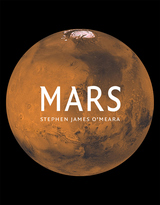
Mars
Stephen James O'Meara
Reaktion Books, 2020
Mars is a small world with a big reputation. This mysterious, singular planet—with volcanoes that dwarf Mount Everest, a canyon system that would stretch fully across the United States, and curious landscapes that perhaps once harbored water—has fascinated us for centuries. In the most up-to-date account available of the elusive Red Planet, Stephen James O’Meara follows our longstanding love affair with this unique celestial body, from the musings of humanity’s first stargazers to the imaginings of science-fiction writers, radio broadcasters, and filmmakers, to the latest images and discoveries from the Curiosity rover. The book also reviews plans for piloted missions to Mars—and what it will take for those missions to succeed.
[more]
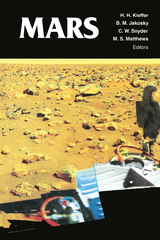
Mars
Edited by H. H. Kieffer, B. M. Jakosky, C. W. Snyder, and M. S. Matthews
University of Arizona Press, 1992
The planet Mars has been a subject of wonder for millennia, as attested by its place in mythology, by later speculation about its canals, and by the scientific and public excitement over the Viking mission. Although the scientific literature about the planet is voluminous, no comprehensive treatment of the results of modern spacecraft exploration has yet been made available. This volume fills that gap by providing a summary of what is presently known about Mars and identifying many puzzles such as polar cap variance, occurrence of dust storms, and the possible location of water. The introductory chapter cites questions, controversies, and milestones in the study of Mars, and also includes an annotated book list, basic data about the planet, and a guide to Martian seasons. A chapter on telescopic observation credits the contributions made by many amateurs that have advanced our knowledge of variations observed on Mars. A chapter on spacecraft exploration, by an American and a Russian author who have participated in all Mars missions, includes a revelation of an additional Soviet attempt. Twenty-nine technical articles cover geophysics; bedrock geology; surface; atmosphere; exosphere and magnetic field; and climate history. Two chapters address the search for life on Mars; three concluding chapters consider the Martian satellites. An indispensable reference for scientists, Mars will also serve as a complete sourcebook for serious amateur astronomers.
[more]
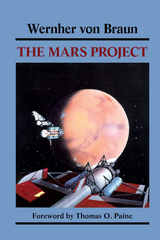
The Mars Project
Wernher Von Braun
University of Illinois Press, 1953
This classic on space travel was first published in 1953, when interplanetary space flight was considered science fiction by most of those who considered it at all. Here the German-born scientist Wernher von Braun detailed what he believed were the problems and possibilities inherent in a projected expedition to Mars.
Today von Braun is recognized as the person most responsible for laying the groundwork for public acceptance of America's space program. When President Bush directed NASA in 1989 to prepare plans for an orbiting space station, lunar research bases, and human exploration of Mars, he was largely echoing what von Braun proposed in The Mars Project.
Today von Braun is recognized as the person most responsible for laying the groundwork for public acceptance of America's space program. When President Bush directed NASA in 1989 to prepare plans for an orbiting space station, lunar research bases, and human exploration of Mars, he was largely echoing what von Braun proposed in The Mars Project.
[more]
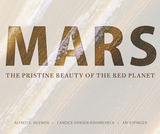
Mars
The Pristine Beauty of the Red Planet
Alfred S. McEwen, Candice Hansen-Koharcheck, and Ari Espinoza
University of Arizona Press, 2017
HiRISE is the most powerful camera ever sent to another planet, showing us Mars in astonishing detail. Featuring an outstanding and never-before-published collection of HiRISE high-resolution color images with explanatory captions in twenty-four languages, this book offers a unique volume produced from an active NASA mission.
Mars enthusiasts will appreciate these perfect snapshots of our current understanding of Mars, with soon-to-be classic pictures that have come to define our vision of the Red Planet. These images and their interpretations will be held as a yardstick for future exploration as we learn more about the surface and geologic processes of the fourth planet from the Sun.
With tantalizing and artistic glimpses at actively eroding slopes, impact craters, strange polar landscapes, avalanches, and even spectacular descent pictures of probes like the Phoenix Lander and the Mars Science Laboratory, we see what researchers are seeing.
Through vivid and beautiful images, this book underscores the need for such a camera on future orbiters, especially as more landing missions are planned. Mars: The Pristine Beauty of the Red Planet provides a stunning keepsake of one of humanity’s greatest accomplishments in space travel.
Mars enthusiasts will appreciate these perfect snapshots of our current understanding of Mars, with soon-to-be classic pictures that have come to define our vision of the Red Planet. These images and their interpretations will be held as a yardstick for future exploration as we learn more about the surface and geologic processes of the fourth planet from the Sun.
With tantalizing and artistic glimpses at actively eroding slopes, impact craters, strange polar landscapes, avalanches, and even spectacular descent pictures of probes like the Phoenix Lander and the Mars Science Laboratory, we see what researchers are seeing.
Through vivid and beautiful images, this book underscores the need for such a camera on future orbiters, especially as more landing missions are planned. Mars: The Pristine Beauty of the Red Planet provides a stunning keepsake of one of humanity’s greatest accomplishments in space travel.
[more]
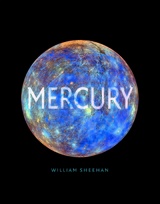
Mercury
William Sheehan
Reaktion Books, 2018
The Sun may be a mass of incandescent gas, but in the plasmatic reaches of its solar winds spins another seemingly glowing (but relatively minute) orb. The last of the five naked-eye planets discovered in ancient times, Mercury has long been an elusive, enigmatic world. As seen from the Earth, it never emerges far from the Sun, and astronomers in the telescopic era found it challenging to work out basic data such as its rotation period, the inclination of its axis, and whether or not it possessed an atmosphere.
In this fully up-to-date and beautifully illustrated account, William Sheehan describes the growth of our knowledge of planet Mercury. From the puzzles it posed for early astronomers to radar studies in the 1960s, and from the first spacecraft fly-bys by the Mariner 10 probe in the 1970s to the latest images from the Mercury Surface, Space Environment, Geochemistry, and Ranging (MESSENGER) orbital mission between 2011 and 2015, Mercury has slowly been brought into clear focus. But although we have now mapped its surface in exquisite detail, revealing strange features like volcanic plains and water-ice deposits in craters near the poles, mysteries remain—such as why its core has the highest iron content of any body of the Solar System. Rather than growing duller on closer acquaintance, this most mercurial of planets continues to fascinate us, offering important clues to scientists as they seek to better understand the origin and evolution of the Earth.
In this fully up-to-date and beautifully illustrated account, William Sheehan describes the growth of our knowledge of planet Mercury. From the puzzles it posed for early astronomers to radar studies in the 1960s, and from the first spacecraft fly-bys by the Mariner 10 probe in the 1970s to the latest images from the Mercury Surface, Space Environment, Geochemistry, and Ranging (MESSENGER) orbital mission between 2011 and 2015, Mercury has slowly been brought into clear focus. But although we have now mapped its surface in exquisite detail, revealing strange features like volcanic plains and water-ice deposits in craters near the poles, mysteries remain—such as why its core has the highest iron content of any body of the Solar System. Rather than growing duller on closer acquaintance, this most mercurial of planets continues to fascinate us, offering important clues to scientists as they seek to better understand the origin and evolution of the Earth.
[more]
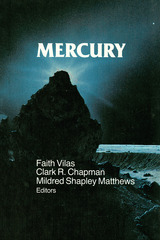
Mercury
Edited by Faith Vilas, Clark R. Chapman, and Mildred Shapley Matthews
University of Arizona Press, 1989
"At its best in synthesizing [current available] information to derive theories about the geological and tectonic histories of the planet ."—Science Books & Films
"This book is another in the excellent University of Arizona Space Science Series, each of which is based on a conference. . . .but goes far beyond a conference proceedings to present a comprehensive summary of current knowledge. . . .I recommend this book as a valuable compendium of current knowledge."—Pageoph
"This collection will be a most valuable addition to any research library."—Choice
"This book is another in the excellent University of Arizona Space Science Series, each of which is based on a conference. . . .but goes far beyond a conference proceedings to present a comprehensive summary of current knowledge. . . .I recommend this book as a valuable compendium of current knowledge."—Pageoph
"This collection will be a most valuable addition to any research library."—Choice
[more]
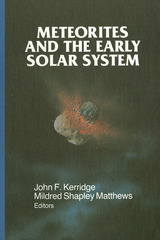
Meteorites and the Early Solar System
John F. Kerridge
University of Arizona Press, 1988
First published in November 1988, this work provided a coherent narrative about the known understandings of meteorites and the early solar system.
From the original publication:
From the original publication:
Although the Earth was formed, together with the other planets, at the birth of the solar system, geological activity has since erased all but a hint of the processes that accompanied its formation. If we wish to explore the processes that occurred in the earliest solar system, and the nature of the environment in which they took place, we must turn to the record contained in more primitive material. Many meteorites appear to satisfy that criterion, and much effort has been applied in identifying those meteorites, or their constituents, that have retained a reliable record of the early solar system. This book provides a synthesis of what has been learned so far about the earliest stages of solar system history through the study of meteorites, and what, given our current level of understanding, remains to be learned.
Contents 1. Introduction 2. Source Regions 3. Secondary Processing 4. Irradiation Effects 5. Solar System Chronology 6. Chondrites and the Early Solar System 7. Elemental Composition of Chondrites 8. Magnetic Fields in the Early Solar System 9. Chondrules10. Primitive Material Surviving in chondrites11. Micrometeorites12. Inhomogencity of the Nebula13. Survival of Presolar Material in Meteorites14. Nucleosynthesis15. Nucleocosmochronology16. Summary
Contents 1. Introduction 2. Source Regions 3. Secondary Processing 4. Irradiation Effects 5. Solar System Chronology 6. Chondrites and the Early Solar System 7. Elemental Composition of Chondrites 8. Magnetic Fields in the Early Solar System 9. Chondrules10. Primitive Material Surviving in chondrites11. Micrometeorites12. Inhomogencity of the Nebula13. Survival of Presolar Material in Meteorites14. Nucleosynthesis15. Nucleocosmochronology16. Summary
[more]
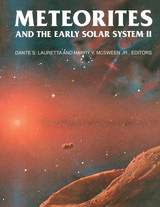
Meteorites and the Early Solar System II
Edited by Dante S. Lauretta and Harry Y. McSween
University of Arizona Press, 2006
They range in size from microscopic particles to masses of many tons. The geologic diversity of asteroids and other rocky bodies of the solar system are displayed in the enormous variety of textures and mineralogies observed in meteorites. The composition, chemistry, and mineralogy of primitive meteorites collectively provide evidence for a wide variety of chemical and physical processes. This book synthesizes our current understanding of the early solar system, summarizing information about processes that occurred before its formation. It will be valuable as a textbook for graduate education in planetary science and as a reference for meteoriticists and researchers in allied fields worldwide.
[more]

The Milky Way
Fifth Edition
Bart J. Bok and Priscilla F. Bok
Harvard University Press, 1981
A swirling spiral of 100 billion star-suns, star clusters, nebulae, and cosmic dust, the Milky Way is our home galaxy and, for astronomers, a source of endless fascination. Since 1941 The Milky Way has conveyed Bart and Priscilla Bok’s own fascination with our galaxy in an authoritative yet easily understandable account. For two generations this immensely popular book has been the standard introduction to the Milky Way, but once again, scientific advances have demanded a complete revision and thorough updating. In just the last decade an entirely new model of a much more massive Milky Way has emerged, and new techniques of radio and infrared astronomy have opened up the full study of the galactic center. As in earlier editions, presentation of new research and dynamic new theoretical advances will delight amateur and professional stargazers alike.
[more]
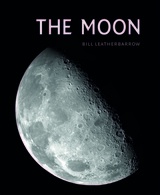
The Moon
Bill Leatherbarrow
Reaktion Books, 2018
The moon has always been the most obvious feature in our night sky. It is our nearest celestial neighbour, orbiting the earth at an average distance of 384,400 kilometers, and is large enough to display significant detail even to the unaided eye. Our moon has drawn observers since the dawn of humankind, and all people have tried to make sense of the puzzles it poses and the questions it raises. The moon provided our ancient ancestors with one of the earliest means of keeping and measuring time, and many early religions had cults that worshipped it. When it eclipses the sun it provides one of the most awe-inspiring views in nature.
In The Moon, celebrated amateur astronomer Bill Leatherbarrow provides expert insight into the history of our study of this compelling astronomical body. Drawing on his own decades of lunar observation, he describes how and why the observation and study of the moon has evolved, particularly in the age of telescopic study. He also offers an overview of current scientific thinking and developments in lunar science since the advent of the Space Age, even providing practical advice on how to make your own observations of the moon. Extensively illustrated with images of the lunar surface taken both from spacecraft and using amateur equipment, this book is an accessible introduction to complex astrophysical concepts that will give all amateur astronomers and anyone fascinated by this natural satellite something to moon over.
In The Moon, celebrated amateur astronomer Bill Leatherbarrow provides expert insight into the history of our study of this compelling astronomical body. Drawing on his own decades of lunar observation, he describes how and why the observation and study of the moon has evolved, particularly in the age of telescopic study. He also offers an overview of current scientific thinking and developments in lunar science since the advent of the Space Age, even providing practical advice on how to make your own observations of the moon. Extensively illustrated with images of the lunar surface taken both from spacecraft and using amateur equipment, this book is an accessible introduction to complex astrophysical concepts that will give all amateur astronomers and anyone fascinated by this natural satellite something to moon over.
[more]
READERS
Browse our collection.
PUBLISHERS
See BiblioVault's publisher services.
STUDENT SERVICES
Files for college accessibility offices.
UChicago Accessibility Resources
home | accessibility | search | about | contact us
BiblioVault ® 2001 - 2024
The University of Chicago Press









